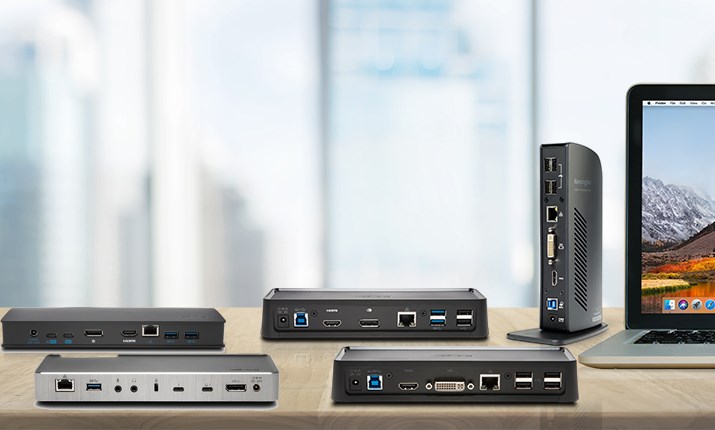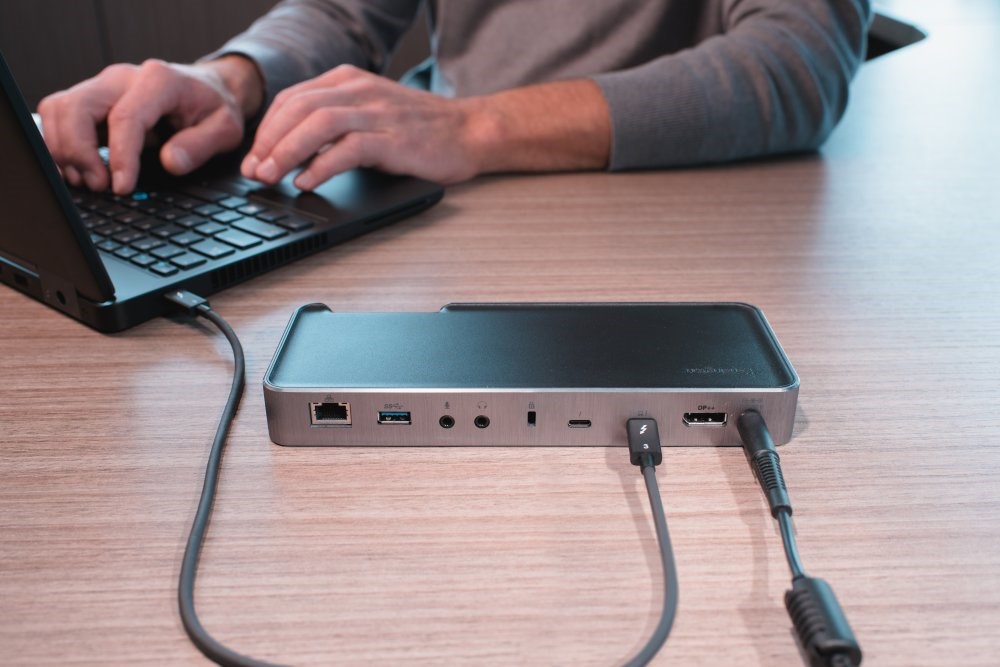
These days, we don’t just do our computing on laptops. We use mobile phones, tablets, and an arsenal of peripheral devices. But while our devices keep getting smaller, fundamental human mechanics haven’t changed. Our hands and bodies are still the same size, after all! We may love our tiny gadgets, but we also want full-size monitors and keyboards to avoid putting excess strain on our wrists and necks. We need more ways to connect our devices to each other, but sizing down tech often means removing input/output ports. This is where a docking station can be a lifesaver—a hub at your desk that turns a jumble of devices into a functioning ecosystem.
Docks aren’t a new concept; they’ve existed ever since laptops hit the market twenty years ago. Those old-style docks were bulky and restrictive. Users had to seat a laptop onto a mechanical connector on a station designed to fit only one specific brand and model. Nowadays, users can plug a host of different kinds of computers and gadgets into one of Kensington’s universal docking stations—and that’s partly because of recent revolutions in input/output ports.
There are two ways that connection technologies have upped their game over the years: the shape of the physical port, and the speed of data transfer. We’ve come a long way from the first USB, but the proliferating types of ports can be confusing. There’s an alphabet soup of acronyms that refer to the port’s material shape (USB-A, USB-B, USB-C) and to the underlying technology that makes up the port's innards (USB. 2.0, USB 3.0, USB 3.1, Thunderbolt). I'm going to demystify the differences between the three most important connector technologies you're likely to encounter: the new USB-C shape, and the USB 3.0 and Thunderbolt technologies.
- Do you have a device like the HP Spectre, Acer Aspie, Dell XPS or MacBook Pro? Learn more about USB-C
- Do you have a device like the Dell Precision M6500, HP EliteBook 8540 or the Asus 1015PEM Notebook? Learn more about USB 3.0
- Do you have a device like the MacBook Pro 2016 or 2017, Lenovo Yoga, HP Spectre x360, Alienware AW15R3? Learn more about Thunderbolt
USB-C
Right off the bat, let’s get something straight. Comparing USB-C to USB 3.0 or to Thunderbolt is like comparing apples to oranges. USB-C refers to the shape of a physical port, while USB 3.0 and Thunderbolt are related to speed of data transfer. These days, lots of companies are switching to USB-C shaped ports. So, why is USB-C an improvement over older shapes?
USB connector shapes have changed a lot since the familiar rectangular shape (called USB-A) entered the market. The original boxy USB-A port worked well with larger devices like computers, but was too big for thin devices like phones and tablets. The USB-B (mini-USB or micro-USB) worked well for those smaller gadgets, but wouldn't it be better if there were a shape that worked for both large and small devices? That's what the USB-C aims to do: to be a new connector standard that every type of device can use.
USB-C’s pill-shaped connector is slim, flat, and compact enough to work in our tiny phones and tablets as well as in our bigger devices. The old box-like USB-A was not only bigger, but it also plugged in only one way (which, somehow, was never the first way you tried it). USB-C solves that problem because its small oval shape is symmetrical and reversible—it works the same no matter which side is up. Even better, despite being smaller than the boxy USB-A, the USB-C is much more powerful because it fits more pins (the conduits that transfer power, data, and, in the case of USB-C, video) into its tinier form. USB-C is a powerhouse physical shape—slim enough to plug in to a thin cell phone, but capable of connecting all the peripheral devices you’d want to your laptop.
Someday in the future, it’s possible that all devices might have only USB-C ports, eliminating the need for lots of different cables. Unfortunately, we don’t live in that future quite yet. Don’t worry, though, USB-C is backward compatible and can work with lots of other kinds of ports via an adapter. But that versatility creates one complication to be aware of: USB-C is just a physical connector shape, and knowing that a port is USB-C doesn’t actually tell you anything about the underlying technology in that port. A USB-C shaped port might have older USB 3.0 technology inside, or it might have more powerful Thunderbolt technology inside if it’s got a little lightning symbol nearby.
A quick internet search can usually tell you what underlying technology is in your USB-C port—but you have to know to look! Fortunately, Kensington has a range of docks to fit every need, including the SD4700P “crossover” dock with a tethered dongle that’s ready to handle both older USB-A and cutting-edge USB-C shaped ports, and a downloadable software driver that will take the guesswork out of connections. Docking has a vital part to play in today’s changing world by bridging your older devices with cutting-edge USB-C machines.
See All of Kensington's Universal Docking Stations
USB 3.0
Look around your house, and you’re almost sure to find at least a few devices that use a Universal Service Bus (USB) port. While many of us use the word “USB” as a kind of blanket term to refer to an input/output port (commonly the rectangular port we see on thumb drives, mice, or keyboards), the term “USB” actually can refer to two different aspects of, say, a thumb drive port: the shape of the port, and the underlying technology that enables data transfer. Fortunately, there’s a pretty easy code to crack. USB refers to the physical shape when it’s followed by a letter (USB-A is the rectangular shape, USB-B is typically a trapezoid, USB-C is the tiny new oval shape). USB refers to the underlying technology when it’s followed by a number (USB 1.0 through USB 3.0 and, most recently, USB 3.1). So, USB 3.0 is a data transfer technology that can be found in ports of several different shapes.
USB 3.0, which made its debut in 2008, is by now a familiar technology in our lives. USB 3.0 is often associated with the classic rectangular USB-A ports partly because the technology was designed around that port, which has nine pins that transfer data and power inside its boxy shape. It’s important to know that since USB 3.0 doesn’t actually refer to the physical rectangular object—it refers to what we might call the “guts” inside the USB— it can work with other connector shapes as long as they have nine connector pins. In fact, you can find USB 3.0 inside some new pill-shaped USB-C ports.
USB 3.0 technology is limited by its design to only be able to transfer 5Gb of data per second, which prevents it from taking full advantage of the USB-C’s extra data and video transfer capacity. Luckily, Kensington’s SD4700P dock enables users to transfer video through a USB 3.0 cable just by downloading a software driver so the dock does all the work. The SD4700P is also a “crossover” dock for USB-C and USB 3.0, which makes things easy for those of us with devices that use a range of different I/O ports by including a USB-C shaped cable with a tethered dongle adapter on one end to fit rectangular USB-A ports. With advances in docking, we can keep our beloved USB 3.0 devices in sync with all our other tech gadgets.
See All of Kensington's Universal Docking Stations
Thunderbolt 3
If you want an input/output port at the cutting edge of power and data transfer, you want Thunderbolt 3. This Intel technology, now in its third version, is becoming the universal standard superport. Thunderbolt 3 doesn’t refer to the shape of the port, but instead to the underlying technology that enables power, video, audio, and data connection through a single port. You might have seen its earlier versions in previous generations of Macs, fit into a MiniDisplay Port shape. Now Thunderbolt 3 technology has come of age, and can be found in both Macs and PCs inside the pill-shaped USB-C port (look for the tiny lightning bolt symbol).
Thunderbolt 3 lets users transfer record amounts of power, data, video, and audio at the same time using one slim oval-shaped USB-C port. Thunderbolt 3 can pass up to 40 Gb/s data, which is an impressive eight times more than USB 3.0’s max of 5 Gb/s. By passing more data more quickly, Thunderbolt 3 is changing the way we use computers. For instance, modern industries like film can shoot a movie in 4K footage, and transfer enormous amounts of data so quickly that scenes can be edited on set—and reshot immediately if necessary. In our everyday lives, Thunderbolt’s multitasking technology decreases clutter on our devices by consolidating extra power ports, video ports, data ports, and even audio ports—you can do it all with just one Thunderbolt port.
Being so far ahead of the rest of the pack has advantages and disadvantages. All the new Thunderbolt 3 ports are USB-C oval shapes, but unfortunately, not all USB-C shaped ports have Thunderbolt 3 as their underlying technology. Instead, a USB-C port without the lightning-shaped Thunderbolt 3 symbol might have any of several other technologies such as USB 3.0. On the plus side, if you plug a less-powerful USB-C device into a Thunderbolt 3 port, the device will work normally. However, a Thunderbolt 3 device needs a Thunderbolt 3 port on the other end, and it can’t function if it’s plugged into a less-powerful USB-C port. Until there’s a universal standard, users are going to need an adapter to let their Thunderbolt devices talk to their other gadgets. Our Thunderbolt 3 Universal Docking Station, the SD5200T, is designed to simplify things by connecting any Thunderbolt 3 device with a variety of peripheral devices, which become compatible with your Thunderbolt 3 device. With Thunderbolt 3, you can reach the upper limits of what a single superport can do.
See All of Kensington's Universal Docking Stations
Win Gold by Getting Ahead of the Curve with Universal Docking
We find ourselves in an exciting time with the ability to transfer more data and power between our devices than ever before. We’re not quite to a golden age where we’ll have one type of cable to power and connect our computers and all our peripheral devices—although that day may be approaching sooner than we think! During today’s messy transition phase, we’ll need flexible and universal docks to help us join all these I/O port shapes and technologies. It may take a few years more until you can finally throw away your miscellaneous cables, but the connected future looks bright!